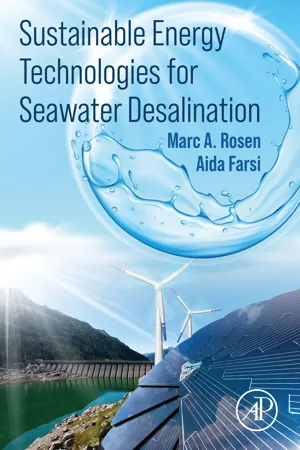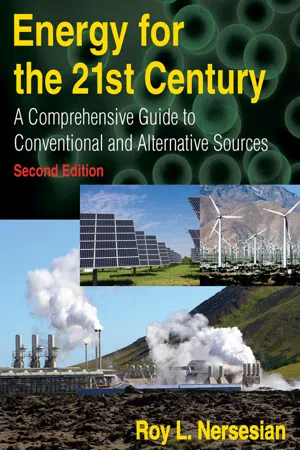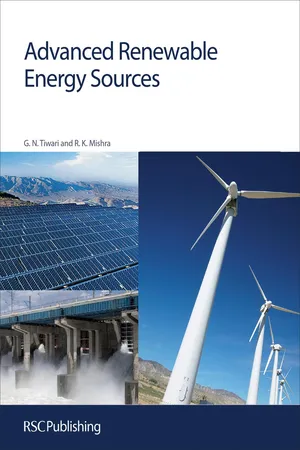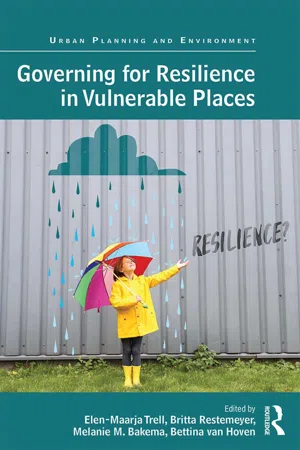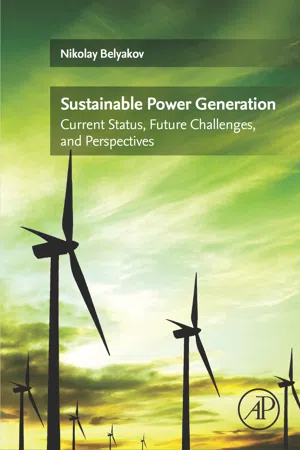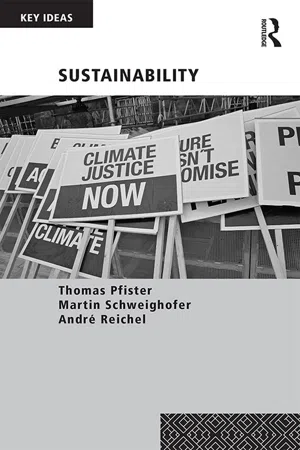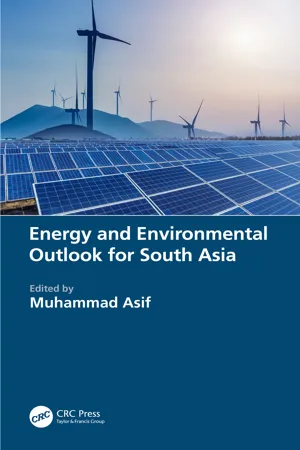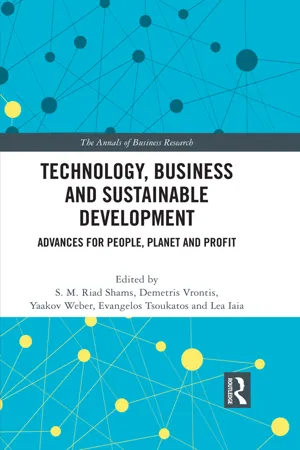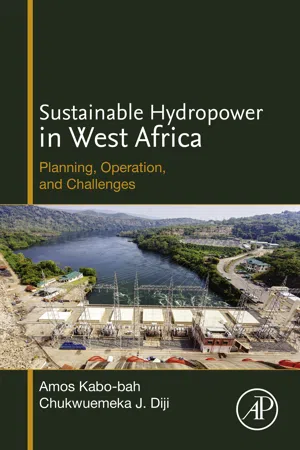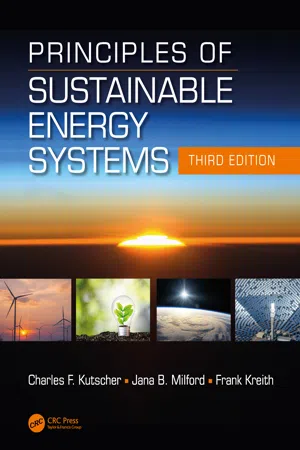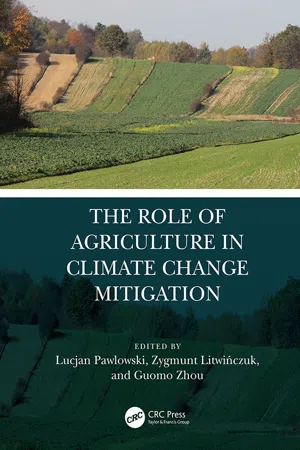Geography
Sustainable Energy
Sustainable energy refers to energy sources and practices that meet present needs without compromising the ability of future generations to meet their own needs. It involves using renewable resources such as solar, wind, and hydroelectric power, as well as promoting energy efficiency and reducing environmental impact. Sustainable energy aims to minimize the depletion of natural resources and reduce greenhouse gas emissions.
Written by Perlego with AI-assistance
Related key terms
11 Key excerpts on "Sustainable Energy"
- Marc A Rosen, Aida Farsi(Authors)
- 2022(Publication Date)
- Academic Press(Publisher)
Rosen, 2021 ), due to its particular fit with the needs of this chapter.Sustainable Energy is a holistic concept that encompasses, but extends well beyond, Sustainable Energy resources. Sustainable Energy necessitates the Sustainable Energy use in energy systems, which include processes for obtaining energy sources, converting them to utilizable forms of energy when necessary or desirable, transporting and storing energy, and using energy. Energy is typically used to provide energy services such as providing thermal comfort, transportation, lighting, and operating a phone. Thus, Sustainable Energy necessitates the existence and use of Sustainable Energy systems and processes.Sustainable Energy is a subset or component of overall sustainability. Most countries, regions, and cities are striving for sustainability and thus are reevaluating their use of energy, which at present is for the most part far from sustainable. In simple terms, sustainability can be viewed as having environmental, economic, and social dimensions. Energy interacts with each dimension, making Sustainable Energy a very important component of sustainability. For instance, energy wastes are discarded into the natural environment while energy resources are extracted or harvested from the environment. As energy is needed for most activities, the attainment of Sustainable Energy is important to achieving sustainability.Significant environmental, social, and economic challenges are associated with energy, including climate change, increasing pollutant emissions, rapid resource consumption, affordability, and social inequities. These must be addressed adequately for Sustainable Energy to be achieved. But doing so can be difficult and complex. For instance, energy prices are in part artificial, being affected by taxes as well as incentives and rebates, while the economics and politics of energy change across countries and over time.- eBook - ePub
Energy for the 21st Century
A Comprehensive Guide to Conventional and Alternative Sources
- Roy Nersesian(Author)
- 2014(Publication Date)
- Routledge(Publisher)
9 ____________________________________ ____________________________________Sustainable Energy
This chapter discusses the meaning of sustainability and the principal Sustainable Energy sources: wind, solar, geothermal, and ocean (tidal, wave, and thermal). Their contribution to meeting world energy needs, along with their relative reliability compared to fossil fuels, will also be covered. Two sources of Sustainable Energy have already been dealt with: biomass in Chapter 3 and hydropower in Chapter 8 . Some feel that nuclear power also qualifies as a Sustainable Energy source if reprocessing of spent fuel and breeding fuel can extend the life of uranium reserves for thousands of years.
Sustainabiiity is a modern-day concept, but it has deep roots as expressed by the following quote from Thomas Jefferson:THE MEANING OF SUSTAINABILITYThen I say the earth belongs to each.… generation during its course, fully and in its own right. The second generation receives it clear of the debts and encumbrances, the third of the second, and so on. For if the first could charge it with a debt, then the earth would belong to the dead and not to the living generation. Then, no generation can contract debts greater than may be paid during the course of its own existence. (1789)Actually, this refers to financial sustainability where the debts of one generation should not encumber the next. It is a poignant countermark to the trillions of dollars that have been piled on the national debt along with assumed government guarantee obligations, not only in the United States but throughout the developed world, to keep the global, financial system afloat and prevent national economies from crashing. But is it fair for one generation to mortgage the future of several generations for its benefit? And how can layering of more debt on top of a system awash with debt that cannot be repaid by debtors be a sustainable solution? - eBook - ePub
- Gopal Nath Tiwari, Rajeev Kumar Mishra(Authors)
- 2015(Publication Date)
- Royal Society of Chemistry(Publisher)
CHAPTER 10 Sustainable Environment10.1 INTRODUCTION
For a sustainable environment we require long term strategies for energy related issues. In this regard, the use of renewable energy resources is likely to be one of the most efficient and effective solutions. Renewable technologies have been considered to be substantially safer. They can be a solution to many environmental and social problems associated with conventional fossil fuels.There has been active worldwide research and development in the field of renewable energy resources and systems since the oil crisis in the 1970s. Renewable energy conversion technologies appeared to be most attractive due to the cost effectiveness and easy implementation. Renewable energy technologies produce marketable energy by converting natural phenomena into useful energy forms.1 These technologies use solar energy directly or indirectly for a continuous stream of energy. It warms us, causes crops to grow via photosynthesis, heats the land and sea differentially, which causes winds and consequently waves and, of course, rain leading to hydropower. Tidal rise and fall is the result of the gravitational pull of the Moon and the Sun. Geothermal energy is available from the heat of the Earth’s core. These renewable resources represent a massive energy potential equivalent to fossil fuel resources.The exploitation of renewable energy resources through various technologies is a key component of sustainable environment. They have been considered to offer less environmental degradation compared to other conventional sources (fossil fuels) of energy. In spite of their sustainability and renewability, they are generally diffuse and not fully accessible. Some are intermittent and have distinct regional variability.Furthermore, in more recent times, it has been realised that application of renewable sources and systems has an adverse impact on the environment. They have become important as environmental concerns due to utility (hydro) costs climbing and labour costs escalating.2 - eBook - ePub
- Elen-Maarja Trell, Britta Restemeyer, Melanie M. Bakema, Bettina van Hoven, Elen-Maarja Trell, Britta Restemeyer, Melanie M. Bakema, Bettina van Hoven(Authors)
- 2017(Publication Date)
- Routledge(Publisher)
On the one hand, a spatial perspective can support the development of a more resilient energy system. Renewable energy production depends on local circumstances, ranging from climatic conditions, topography, economic investment opportunities and available social capital. Hence, taking a spatial perspective can assist in developing an energy system that, through adapting to diverse local circumstances, creates alternative development paths for regional energy systems. This will not only support the development and improvement of alternative technologies needed within the energy system but also allow for the exchange of energy between regions. For example, hydroelectricity or biomass can generate energy in one region to compensate for a lack of sun or wind due to weather conditions in another region.On the other hand, adapting renewable energy systems to local circumstances helps renewable energy to become embedded within a regions’ socio-economic fabric. The result is that renewable energy might well support existing economic activities such as agriculture, chemical industries, transportation or port activities. It can also create new economic pathways, generate jobs or support local liveability. The financial gains from energy production can be used for local investments in local services such as schools, mobility, housing or nature management. This could lead to renewable energy production becoming part of a strategy to improve a region’s resilience.The discussion below in section two focuses on how the shift towards a Sustainable Energy system urges us to discuss the relationship between the energy system and the physical and socio-economic landscape in which it is embedded. This discussion provides a background for the subsequent investigation. This investigation begins in section three with exploring the two interrelated challenges of the shift towards Sustainable Energy landscapes for spatial planning. In section four, the investigation continues by explaining how the notion of resilience can help us to better understand how spatial planners might respond to these challenges.Sections five and six contain the results of an empirical investigation into how the shift towards a more Sustainable Energy system might assist in creating both more resilient regions and a more resilient energy system. Data was gathered within the 2012–2015 MACREDES (‘MApping the Contextual conditions for Resilient Decentralised Energy Systems’) project that the author participated in. Within this interdisciplinary project, the author was part of a team studying the spatial dimensions of the shift towards an energy system based on more renewables. The research involved a study of multiple cases of locally based renewable energy initiatives, of (regional and national) research reports, of supervising and guiding master theses, several workshop sessions and over ten semi-structured interviews with government representatives. Although MACREDES provides important empirical insights for this chapter, it is important to note that this overall chapter takes a more theory-led perspective to explicitly argue and illustrate the relevance and possible use of a resilience perspective in pursuing a transition towards a more Sustainable Energy system. Finally, in section seven, a reflection will follow and some concluding remarks are presented. - eBook - ePub
Sustainable Power Generation
Current Status, Future Challenges, and Perspectives
- Nikolay Belyakov(Author)
- 2019(Publication Date)
- Academic Press(Publisher)
Chapter FiveSustainable Energy development
Abstract
The concept of sustainability is applied here to the development of the energy and power generating systems to reveal the associated challenges. With the historical outlook and limits to growth, it further outlines global energy production and consumption patterns, including electricity generation. Finally, sustainable development goals related to power generation are discussed in detail, followed by the concept of energy security as a factor of sustainability.Keywords
Sustainable Energy development; energy production; energy demand; energy consumption; electricity generation; sustainable development goals; SDGs; sustainable solution spaceChapter Outline- 5.1 Challenges for Sustainable Energy development
- 5.1.1 Historical outlook of energy development
- 5.1.2 Exponential growth
- 5.1.3 Limits to growth
- 5.2 Global energy production and consumption
- 5.2.1 Energy production
- 5.2.2 Energy demand and consumption
- 5.2.3 Electricity generation
- 5.3 SDGs related to energy system
- 5.3.1 SDG 7: ensure access to affordable, reliable, sustainable, and modern energy
- 5.3.2 SDG 12: ensure sustainable consumption and production patterns
- 5.3.3 SDG 13: take urgent action to combat climate change and its impacts
- 5.4 Energy system within the sustainable solution space
- References
5.1 Challenges for Sustainable Energy development
Reliable and sufficient energy supply is assumed as a key prerequisite for economic growth and cultural and social development in complex societies [1] . According to the cited work [1] , many scholars have come to the conclusion that there exists a correlation between the degree of development of a country and its energy use. The increasing living standards would require higher energy consumption per capita, which would lead to a kind of a “vicious circle” to supply more and more power to maintain the required rate of development and living conditions.Such growth reveals the challenges of sustainable development. With the world aiming to maintain economic growth and increase of population, it requires more and more energy to maintain this motion, which is challenged by multiple limitations of growth. Historically, these challenges have been mitigated in multiple ways, though leading to an unsustainable way of production and consumption. - eBook - ePub
- Thomas Pfister, Martin Schweighofer, André Reichel(Authors)
- 2016(Publication Date)
- Routledge(Publisher)
Chapter 2 , which will be traced throughout the chapter and contrasted with the exemplary projects of renewable energies, the quest for equal access to energy for all and finally the business case of sustainable energies. The discussion elucidates that Sustainability, understood as a precept to respect ecological limits, can at least implicitly be observed in projects that emerged around the utilisation of renewable energies. While equity has been emphasised in the understanding of Sustainability formulated in the Brundtland Report and is still an important value in various projects, recent approaches to Sustainable Energy are set on the understanding of Sustainability as a business case, seeking to balance environmental and economic benefits.The formation of modern energy systemsIn order to better understand the Sustainability challenges arising in contemporary energy systems, we begin this section by briefly reconstructing their historical formation. Energy was always essential for the constitution of human societies. For a long time, the utilisation of energy was limited to relatively simple practices of production and consumption (i.e. local, decentralised, and not requiring the collaboration of specifically skilled people or extensive technological infrastructures) and renewable energy sources. For instance, firewood was burned for heating and cooking, mills and wheels were driven by the power of wind or water, and transportation often rested upon the power of horses or men (see, Sørensen, 1991).1A new chapter was opened in the eighteenth century when coal was first used in steam engines. (This brief historic review draws on Union of Concerned Scientists, 2015.) Subsequently coal became an important fossil energy source fuelling steam engines to run railways and steam ships or to power factories and smelting furnaces for steel production. From now on, the energy mix was gradually shifting towards fossil energy sources. This development gained pace when crude oil as another fossil energy source came up in the late nineteenth century. Initially oil was merely used for minor purposes, but soon considerable amounts were processed and used in combustion engines. Their evolution set the scene for new developments, such as the mass production of cars and the extension of car-centred mobility infrastructures. In addition to transportation, crude oil became the foundation of a variety of new practices and infrastructures, including heating and warm-water systems or various industrial production processes. Also during the late 1800s, electricity systems including power plants and distribution networks emerged and spread quickly. Finally, in the 1950s nuclear technology was applied to develop a new opportunity to produce electric energy. (For a detailed historic account also see Smil, 2004b.) - eBook - ePub
- Muhammad Asif(Author)
- 2020(Publication Date)
- CRC Press(Publisher)
Decade of Sustainable Energy for All”. The word sustainability has become the jargon of the present generation. Sustainability is generally described as the availability of resources for present and future generations. Energy sustainability is also bracketed similarly. But the availability, accessibility, and affordability need to be clearly understood when talking about energy sustainability. Sustainability should also keep a watch on the long-term impacts of present innovative resources. The development and installation of new and renewable energy resources should not take its toll on the future generation. The social angle of sustainability, which is often neglected, plays the most important role in energy sustainability. This section describes the sustainability issues associated with the three major renewable energy resources of India, which are presently neglected but can create havoc in the future.The decentralized approach is constantly neglected in energy scenarios which is the most important pillar of sustainability. The utilization of resources within one's geographical location always maintains the appropriate ecological balance. The decentralized system also reduces the transportation loss of energy.5.7.1 Sustainability in Solar Energy
Solar power is indeed a clean source of energy which is having enormous potential in many parts of the world. Although it is renewable energy, it is largely made up of non-renewable resources. Its limited lifespan and getting obsolete shortly raise a question on its sustainability. The manufacturing of solar panels involves the usage of many substances which are not eco-friendly. For instance, nitrogen trifluoride is a byproduct of electronic manufacturing often used in solar cells; it is a greenhouse gas with 17,000 times higher global warming potential than carbon dioxide. Advanced solar cells are using cadmium in manufacturing which is a toxic heavy metal (Dahren 2016).Solar panels offer a risk of lead, cadmium, and other toxic chemicals contamination in the environment. Approximately 90 percent of photovoltaic (PV) modules are made up of glass, which often cannot be recycled as float glass due to impurities. The glass used is polyvinyl chloride (PVC) consists of many impurities such as plastics, lead, cadmium, and antimony. Many environmentalists articulate that solar panel disposal in regular landfills is not recommended due to the risk of breaking of modules and toxic materials leaching into the soil. One of the local concerns and threats being posed by solar panels is the washing of cadmium with the rainwater. The stand-alone system needs big batteries whose storage and disposal can be a real threat soon. Sustainability also looks for sustainability in the future which looks vague for solar energy (Kazmeyer 2017). - eBook - ePub
Technology, Business and Sustainable Development
Advances for People, Planet and Profit
- S.M. Riad Shams, Demetris Vrontis, Yaakov Weber, Evangelos Tsoukatos, Lea Iaia, S.M. Riad Shams, Demetris Vrontis, Yaakov Weber, Evangelos Tsoukatos, Lea Iaia(Authors)
- 2023(Publication Date)
- Routledge(Publisher)
12 Sustainable Development of Regional Energy Economy According to Environmental Footprint Methodology Kęstutis Biekša and Violeta Valiulė DOI: 10.4324/9781003293187-12 Introduction Nature is a good example of self-sustained development while an artificially created economy called anthroposphere stimulates the production of waste, increases environmental pollution, and destroys the ecosystem (Čepinskis, 2006). It is not possible to recycle the products (energy) by 100%, but reducing the use of resources and increasing energy efficiency is not difficult. However, achieving 100% recycling or renewable energy may be neither practical nor economically feasible in reality (Zheng and Suh, 2019). Clean, green, and renewable energy technologies are the future of a Sustainable Energy economy but sustainability cannot be attained without social and environmental development (Dobrovolskienė et al., 2021). Renewable energy resources (RES) nowadays have become a target of the economy. They provide the same amount of energy as fossil resources but their productivity needs an improvement (Stoglehner, 2003). The efficient use of local resources and the integration of RES is the future development of the regional energy economy. The process of harmonising RES integration reveals the necessity of local community participation in planning (Goussios et al., 2021). The regional energy economy development is a specific task because every region has specific conditions such as geographical, physical, social, economic, etc., and every region has a distinctive environment for the assimilation of resources (Birkeland, 2012). The regions cannot be separated from the natural and artificial environments and developed as an autarky because the processes are interlinked to the ecosystem (Stoeglehner and Narodoslawsky, 2009). The sustainable development (SD) of the regional energy economy is a complex system where a balance of nature, economy, and social environment is needed (Wang et al., 2020) - eBook - ePub
Sustainable Hydropower in West Africa
Planning, Operation, and Challenges
- Amos T. Kabo-Bah, Chukwuemeka J. Diji(Authors)
- 2018(Publication Date)
- Academic Press(Publisher)
Kazem, 2011 ).Fig. 4 Chart showing static range of the different fossil fuels (Hoffert, 2010 ).SDGs placed an emphasis on modern energy for all, but our current source of energy clearly cannot provide energy for all as enshrined in the SDGs. Therefore, the only hope for the future of West African subregion and the world at large is to tap into the inexhaustible source of energy we have. The West African Subregion has a great RE potential that could be harnessed to help curb the energy crisis we face today.4 Renewable Energy and Sustainable Development
Various factors such as limitation of fossil-fuel resources, negative impacts on environment, fossil-fuel prices, political/social disputes, and their effects on supplying Sustainable Energy are among the reasons that have compelled nations to move toward the development of a modern structure to secure supply of energy, environmental protection, and efficiency improvement of energy systems with economic gains. Hence, most countries have begun to realize that the need for sustainability in energy production and consumption is significantly vital. Fig. 5 shows the scheme for sustainable development as the convergence of three sustainability pillars.Fig. 5 Sustainable development scheme.Historically, energy continues to be the pivot of economic and social development of all countries around the world. Though it has brought great economic prosperity, the way it is produced and used has adversely affected local, regional, and global environments, hence the ongoing debate about making energy systems more sustainable. This debate has largely centered on detailed discussions around the different energy sources and their likely emissions during thermochemical and biological operations. Support has been expressed for RE systems, owing to their more favorable environmental qualities. - Charles F. Kutscher, Jana B. Milford(Authors)
- 2018(Publication Date)
- CRC Press(Publisher)
2 in the ground, and we are releasing all that carbon in a timescale of decades. Although it is technically feasible to capture the carbon in fossil fuels and sequester it in the ground again, the fundamental solution to these issues is to convert our unsustainable, carbon-emitting energy sources to sustainable, carbon-free ones. To accomplish that transition, we need to simultaneously reduce our energy needs by using energy much more efficiently and produce the energy from noncarbon sources. This book introduces the knowledge and tools energy professionals and informed citizens will need to lead this twenty-first-century energy transition.The purpose of this chapter is to give an overview of the principles of sustainability in the context of energy engineering. Section 1.1 gives a historical review of sustainability principles. Section 1.2 presents the critical issues for sustainability: population, water, food and growth, and the relationships between these systems and energy use. Section 1.3 presents some context for the complex nature of Sustainable Energy by looking at the world energy system of the past, present, and future and the urgent challenge of addressing climate change. Section 1.4 explains some of the most important considerations you must understand to effectively deal with sustainability in engineering, including energy return on energy invested (EROI) and the costs of energy. Section 1.5 explains the most cost-effective of all Sustainable Energy strategies—reducing energy demand by improving efficiency. Section 1.6 gives an overview of conventional fossil and nuclear energy. Section 1.7 reviews the technology, history, current status, and future prospects for renewable resources including geothermal, hydro, wind, solar, biomass, and the ocean. Section 1.8 discusses the issues involved in the concept of a hydrogen economy.A unique feature of this book is that it makes use of energy design tools developed by the National Renewable Energy Laboratory (NREL). In particular, this book includes numerous detailed examples of the design of renewable energy systems using the freely available System Advisor Model (SAM). An introduction to SAM is presented in Section 1.9 , whereas NREL building energy modeling tools are utilized in Chapter 4- Lucjan Pawlowski, Zygmunt Litwińczuk, Guomo Zhou, Lucjan Pawlowski, Zygmunt Litwińczuk, Guomo Zhou(Authors)
- 2020(Publication Date)
- CRC Press(Publisher)
Sustainable Energy: Technology, industry, transport and agriculture A. Pawłowski Faculty of Environmental Engineering, Lublin University of Technology, Lublin, Poland1 INTRODUCTION
According to the most widely used definition sustainable development it is development that meets the needs of the present without compromising the ability of future generations to meet their own needs (WCED 1987). It includes basic human needs, like access to water, food and shelter, but also to electricity.Sustainable development is discussed at three levels, i.e. ecological, social, and economic (Borys 2005, Harris et. al. 2001, Singh 2019, Sztumski 2019). In my works I proposed that the discussion should be expanded to include other dimensions. When addressing the multi-dimensional nature of sustainable development, I also pointed to (Pawłowski 2011):the ethical dimension (the question of human responsibility for nature);the ecological dimension (nature conservation, protection of man-created environment, spatial planning);the social dimension (not only the natural environment but also the social environment may undergo degradation);the economic dimension (taxes, grants and other economic instruments);the technical and technological dimension (new technologies, economical use of raw materials);the legal dimension (environmental law);the political dimension (formulation, implementation and enforcement of sustainable development strategies).Above dimensions may be presented in a hierarchical order (Table 1 ).Table 1. The hierarchy of levels of sustainable development (author’s own work).Level I Ethical dimension Level II Ecological dimension Social dimension Economic dimension Level III Technical Dimension Legal dimension Political dimension On the first level I place ethical reflection, which provides a basis for the other levels. It is evident, that when a person takes a decision in line with his/her own convictions and system of values, the situation is quite different from the one when a decision is the result of obligations and prohibitions of the law currently in force.
Index pages curate the most relevant extracts from our library of academic textbooks. They’ve been created using an in-house natural language model (NLM), each adding context and meaning to key research topics.
